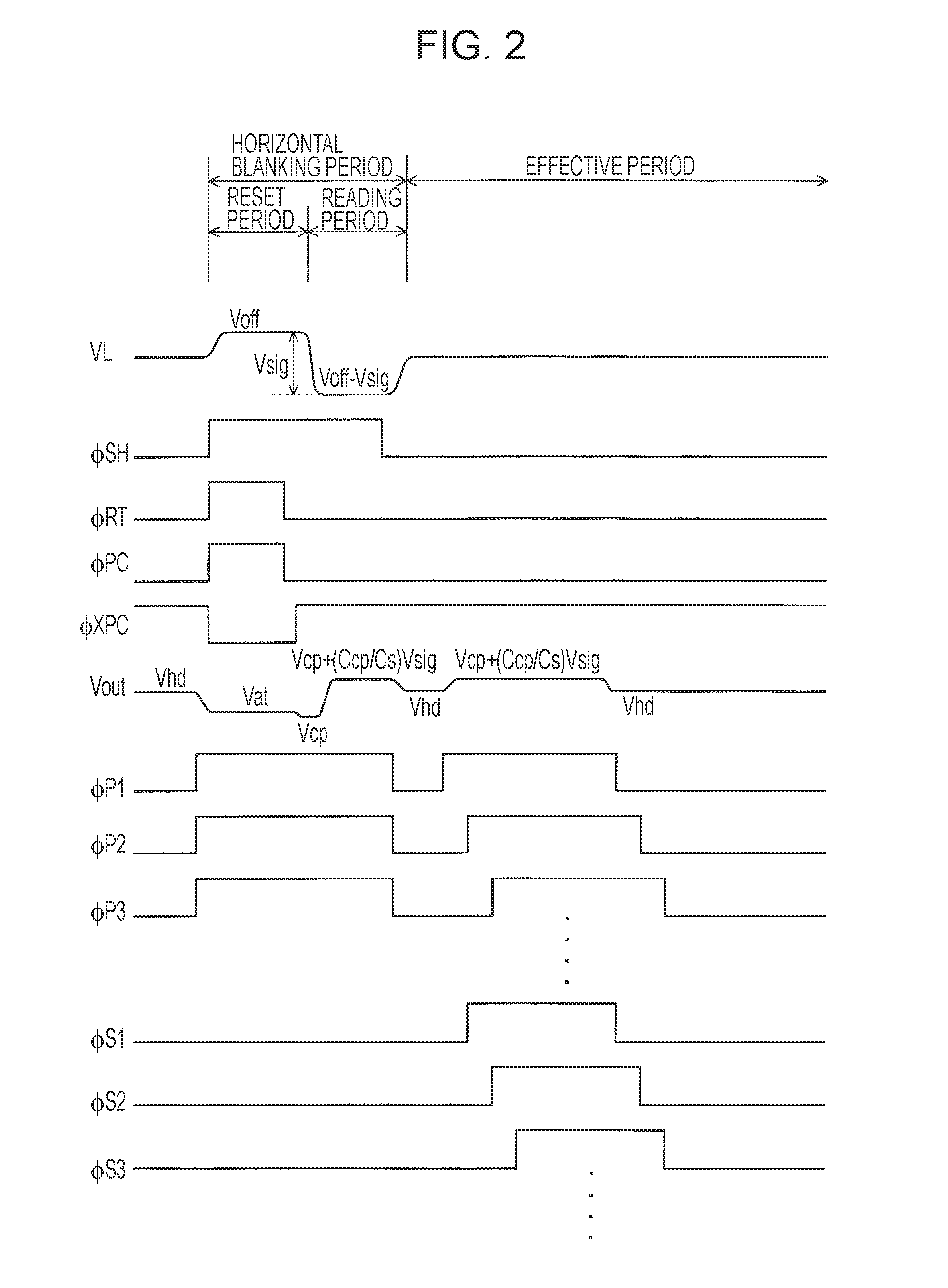Solid-state imaging device, pixel-signal processing method, analog-signal transferring device, and analog-signal transferring method
a solid-state imaging and processing method technology, applied in the direction of color television details, television systems, radio control devices, etc., can solve the problems of unfavorable analog-signal transferring, high power consumption, and complex systems, and achieve the effect of favorable analog-signal transferring
- Summary
- Abstract
- Description
- Claims
- Application Information
AI Technical Summary
Benefits of technology
Problems solved by technology
Method used
Image
Examples
first embodiment
[0082]FIG. 1 shows a construction according to a first embodiment of the present invention. The circuit shown in FIG. 1 allows pixel signals obtained by a pixel array 1 in a solid-state imaging device to be output from an output terminal 10. A lens system for forming a path of light incident on the pixel array 1 and a signal processing system provided at a subsequent stage of the output terminal 10 are not shown, and descriptions thereof will be omitted.
[0083]The pixel array 1 includes a large number of imaging pixels 2 arranged in a row direction and a column direction. Each of the pixels 2 is formed by a photodiode PD, a transferring transistor Ttr, a reset transistor Trst, an amplifying transistor Tg, and a selecting transistor Ts, connected as shown in FIG. 1.
[0084]The selecting transistors Ts of the imaging pixels 2 on each column of the pixel array 1 are commonly connected to a vertical signal line VL (VL1, VL2, . . . VLn).
[0085]Furthermore, in order to allow common control fo...
second embodiment
[0192]FIG. 8 shows a construction according to a second embodiment of the present invention. In the following description of embodiments, parts corresponding to those in FIG. 1 are designated by the same numerals, and descriptions thereof will be omitted.
[0193]The construction shown in FIG. 8 is basically the same as that of the first embodiment shown in FIG. 1, but differs in that signals φS (φS1, φS2, . . . ) output from the horizontal scanning circuit 5 are commonly used as amp controlling signals and amp selecting signals.
[0194]That is, the horizontal scanning circuit 5 supplies the signals φS to control standby of the amps A and to control the switches Shd.
[0195]In the first embodiment described above, the amp controlling signals φP are caused to rise somewhat earlier than the amp selecting signals φS in consideration of the time for the amps A to return from the standby state, as described with reference to FIG. 2. If the amps A do not take much time to return from the standby...
third embodiment
[0199]FIG. 11 shows a third embodiment of the present invention. In this embodiment, feedback capacitors Csv (Csv1, Csv2, . . . ) of the amps A in the charge integrating amps 9 are implemented by variable capacitors.
[0200]Thus, the term Ccp / Cs in equation (1) becomes variable, so that variable-gain amplifiers are implemented.
[0201]It is to be readily understood that the variable capacitors Cvs can be implemented by allowing selection from a plurality of capacitors by switches. In that case, pulses for selecting capacitance are output from the amp driving circuit 4.
[0202]According to the third embodiment, the function of programmable gain amp (PGA), which is required in a camera system, can be implemented in the charge integrating amps 9. Thus, systems at subsequent stages can be simplified, and the gain is increased at an early stage. Accordingly, sufficient signal amplitude is ensured even when pixel signal levels are small, and insusceptibility to noise is improved.
PUM
 Login to View More
Login to View More Abstract
Description
Claims
Application Information
 Login to View More
Login to View More - R&D
- Intellectual Property
- Life Sciences
- Materials
- Tech Scout
- Unparalleled Data Quality
- Higher Quality Content
- 60% Fewer Hallucinations
Browse by: Latest US Patents, China's latest patents, Technical Efficacy Thesaurus, Application Domain, Technology Topic, Popular Technical Reports.
© 2025 PatSnap. All rights reserved.Legal|Privacy policy|Modern Slavery Act Transparency Statement|Sitemap|About US| Contact US: help@patsnap.com



